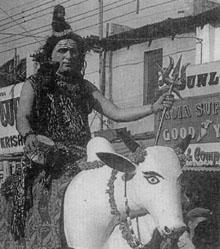 |
|
Actor
dressed as Shiva; Photograph, 1990 A.D.
|
To the unorthodox Vratyas, who stood outside the traditional fold, Shiva was one of them, a non-conformist. Like them he challenged social norms and sought the truth elsewhere, beyond ritual, beyond society, beyond nature, beyond matter. He was first siddha, the first tantrik, the first yoga. He was Adi-Nath, the primeval-master. They sought his blessings as they indulged in alchemy, socrcery, magic and sometimes even in scatophilic, anthropophagic and necrophilic practices. Shiva was their refuge. The Vratyas saw Shiva surrounded by every creature scorned by civilized society: demons, ghosts and goblins. They reveled in the image of Shiva dancing and drinking with his companions, the gans: a rabid mob of bhoot, prêt, rakshas, yaksha, asur, pisach, and vetal.
The Brahmancial order found it difficult to accept this wild god. Like Brahma, they tried to fight him. Like the priest-king Daksha, they held him in contempt. They refused to offer him any portion of their yagnas. But, by the sheer strength of his cosmic truism, Shvia forced his way into their philosophies. By 500 B.C., when sages were writing the Mundaka Upanishad and the Shvetashvatara Upanishad, Shiva had become and important deity. This rityally impure god came to be known, quite ironically, as shiva, the auspicious one.
The Greeks who came to India around 300 B.C. saw in the erotic Shiva a reflection of their own god Zagreus-Dionysys, a mad rebel who stood against classical divinities, surrounded by his own set of ganas, a bunch of lascivious loudmouthed satyrs. Like Shiva, Dionysus was lord of the mountains, the trees, the beasts, wine, dance and theatre. His mystery-cult took the shape of Orphism, that went on to greatly influence the Christian rites of sacrament and communion.